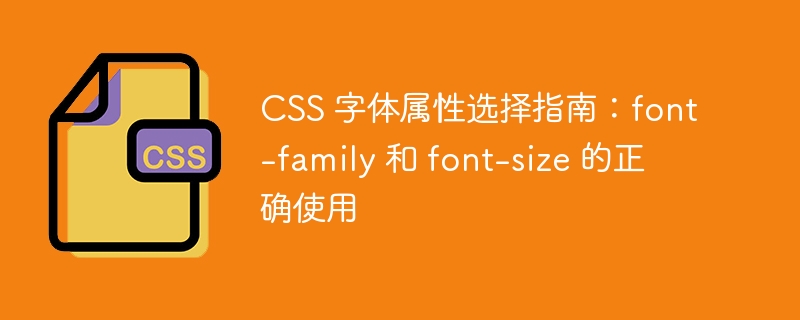
CSS 字体属性选择指南:font-family 和 font-size 的正确使用,需要具体代码示例
引言:
在网页设计中,字体选择是一个重要的方面。一个合适的字体能够增强网页的可读性和美感。在 CSS 中,我们可以通过 font-family 和 font-size 属性来控制字体样式和大小。然而,正确地使用这两个属性是一个有挑战的任务。本文将向您介绍如何正确选择字体样式和字体大小,并提供一些具体的代码示例。
一、font-family 字体样式选择指南:
立即学习“前端免费学习笔记(深入)”;
在选择字体样式时,应优先考虑使用通用字体族。如 "serif","sans-serif","monospace" 等。这些字体族定义了一类字体的整体风格,可以在不同的操作系统和设备上显示一致的效果。以下是一些常见的通用字体族:
body {
font-family: serif;
}
h1 {
font-family: sans-serif;
}
code {
font-family: monospace;
}如果您需要使用特定的字体样式,可以通过指定字体的名称来实现。尽量选择系统默认已安装的字体。如果字体不在用户的系统中,浏览器会使用备用字体进行替代。以下是一个指定字体名称的示例:
h1 {
font-family: Arial, Helvetica, sans-serif;
}如果您希望在网页中使用自定义字体,可以通过 @font-face 规则来加载字体文件。将字体文件放在服务器上,并使用相对或绝对路径来引用它。以下是一个加载自定义字体的示例:
@font-face {
font-family: "MyFont";
src: url("myfont.ttf");
}
h1 {
font-family: "MyFont", sans-serif;
}二、font-size 字体大小选择指南:
在设置字体大小时,使用相对单位是一个良好的实践。相对单位可以根据用户的设备和偏好来自动调整字体大小。以下是一些常见的相对单位:
body {
font-size: 1em;
}
h1 {
font-size: 2em;
}
p {
font-size: 120%;
}在某些情况下,您可能需要使用固定的字体大小。在这种情况下,可以使用绝对单位,如 px,pt 或 rem。以下是一个使用绝对单位的示例:
h1 {
font-size: 24px;
}
p {
font-size: 16pt;
}为了在不同的屏幕尺寸和设备上实现最佳的字体大小,可以使用 CSS 的媒体查询和属性插值。例如,可以根据屏幕宽度自动调整字体大小。以下是一个响应式字体大小的示例:
h1 {
font-size: 24px;
}
@media screen and (max-width: 768px) {
h1 {
font-size: 18px;
}
}
@media screen and (max-width: 480px) {
h1 {
font-size: 16px;
}
}结论:
正确地选择字体样式和字体大小是网页设计中的重要任务。通过使用合适的字体样式和相对单位,可以确保网页的可读性和美感。同时,通过指定字体名称和加载自定义字体,可以实现更具个性化和独特性的设计效果。希望本文提供的指南和示例能够帮助您正确选择和使用字体样式和字体大小。
以上就是CSS 字体属性选择指南:font-family 和 font-size 的正确使用的详细内容,更多请关注php中文网其它相关文章!

每个人都需要一台速度更快、更稳定的 PC。随着时间的推移,垃圾文件、旧注册表数据和不必要的后台进程会占用资源并降低性能。幸运的是,许多工具可以让 Windows 保持平稳运行。

Copyright 2014-2025 //m.sbmmt.com/ All Rights Reserved | php.cn | 湘ICP备2023035733号